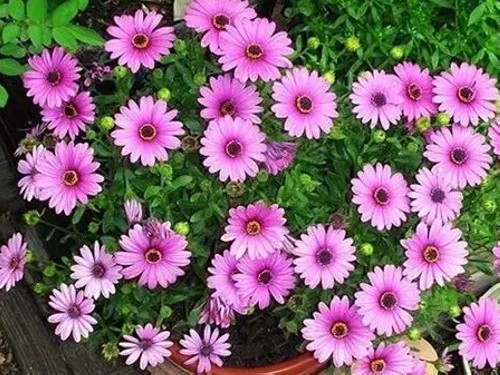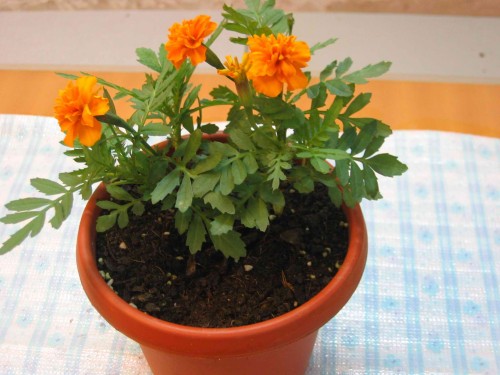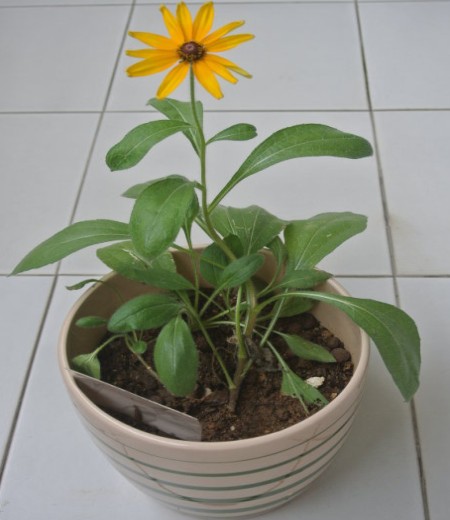Planting method of potted blue chrysanthemum
Since the blue demon began to grow flowers, there has been a very good flower friend, recommended blue chrysanthemum to me, said that it is very worth raising a kind of flower, yes, blue chrysanthemum is indeed very lovable, the flower fresh florescence is also very long. However, blue-eye chrysanthemum is a kind of flower that is easy to raise. Let's talk about the planting method of blue-eye chrysanthemum today.

[sowing method]
Blue chrysanthemum can be propagated by cutting or sowing. The seeds are usually sowed in autumn in September or in spring in March. The germination temperature of blue chrysanthemum seeds is between 18 ℃ and 20 ℃. Many flower friends encounter the situation that the blue chrysanthemum does not germinate when sowing, and the reason for excluding the freshness and plumpness of the seeds is mostly due to the lack of shelling treatment of the seeds.
1. Seed treatment
The seed shell of blue chrysanthemum is hard and thick. Peeling and soaking before sowing can greatly improve the germination rate and speed up the germination rate. If direct broadcast, the germination rate of blue chrysanthemum is very low, or even none of them germinate.
Peel it off from the pointed end with a knife, be careful not to hurt the germ inside, just peel the germ out.
2. Seedling soil
The sown soil can be well mixed with peat and perlite in a certain proportion, and the humidity should be clutched into a ball by hand, and it is appropriate to loosen the hand. When loading the soil, the soil below is slightly compacted to prevent the soil mass from becoming loose when the seedlings are moved in the later stage.
3. Accelerating budding
Sprout with paper towels. After spraying the paper towels, put them on a small plate, cover them with a plastic bag to moisturize, and put them in a cool place to sprout. In order to prevent mildew, low concentration of potassium permanganate water can be used.
4. Sowing seeds
When the seeds are white, they can be sown. Gently take out the seeds and sow them into the seedling basin. First, make a small hole in the middle of the seedling basin, then put the seeds in, gently cover the fine soil, cover with a thin layer of vermiculite, and spray to moisturize. Try to plant a seedling in a small pot to facilitate transplanting.
[seedling management]
After the buds of the blue chrysanthemum are drilled out of the soil, they can be given light to prevent overgrowth. Maintain good ventilation, the soil should not be too wet, should be controlled to see dry and wet is conducive to the fundamental development of seedlings. Good root system is the guarantee of seedling health.
After the seedlings grow to 2 pairs of true leaves, they can apply thinner water-soluble fertilizer once a week, and gradually increase the concentration. The seedlings are more tolerant to drought and do not water them. The time of transplanting seedlings into the pot can be determined according to the size of the sowing pot they use. Generally, one plant can be planted in a basin with a caliber of 20 cm.
If you like to be shorter, you can start spraying Daizhuangsu when you grow to 8 cm high to control the height of the plant. Blue chrysanthemum has a good branching property and a large number of flowers. if you feel that the plant type is not satisfied enough, you can combine topping to control the plant type.
Generally, two months after emergence, the application of nitrogen fertilizer began to reduce, gradually changed to phosphorus and potassium fertilizer, continued to apply phosphate fertilizer after budding, reduced the amount of fertilization or stopped fertilization after flowering.
[florescence management]
Blue chrysanthemum generally takes more than 3 months from sowing to flowering, and gradually enters the full flowering stage in the later stage, when the water demand increases, at this time can not wait until dry before watering, the general soil surface dry can be watered, to keep the soil moist. The flowering period of blue chrysanthemum is very long, which can be as long as 2 months.
5. Prevention and control of diseases and insect pests of blue chrysanthemum
Blue-eye chrysanthemum likes aphids and whitefly. If it is spring-sown blue-eye chrysanthemum, it needs to be sprayed frequently. Seedlings sown in autumn should also be sprayed with insect control drugs every 15-20 days after the beginning of spring.
[summer management]
Blue chrysanthemum can not bear the heat, summer should be placed in astigmatism ventilation place maintenance, to avoid sun exposure, can be placed on the north balcony maintenance. The summer temperature is very high, blue chrysanthemum will stop growing, it is not suitable to apply fertilizer at this time, so as not to cause fertilizer damage. Watering should be thoroughly watered at one time.
Blue chrysanthemum sowing cuttings are relatively easy, if flower friends after sowing to obtain plants, recommend cutting propagation, feel that the top branches in the spring and autumn season any cutting survival rate is quite high.
Usually one of my blue-eye chrysanthemum plants is topped twice during the growing period and planted in a gallon of green pots. I plan to turn the pot two years later and put enough fertilizer (whatever blossoms), so there is basically no need to take special care of it. If the sun and water supply, it will take up to two months from toothpick seedling to flowering.
Blue eye chrysanthemum likes basking in the sun and big fat and big water, so if you want to have enough flowers to watch for a long time, fat water and sunshine tube is enough, a flower can bloom for three or four days, and the flowers will be removed in time to avoid waste of nutrients. I will hit the top again at the end of summer. I don't hit hard, because after a spring and summer, the branch shape is relatively large and scattered, and the number of flowers is also reduced. After topdressing, flowers are full of flowers again in autumn!
Time: 2019-05-25 Click:
- Prev

Planting methods and matters needing attention of potted malachite
Peacock grass, a nickname for yellow chrysanthemum and satin flowers, generally grows in mountains at higher elevations. When it blossoms, its flowers are colorful and rich, as gorgeous as peacocks, so they are called peacock grass. The common colors of malachite flowers are red, yellow, orange and so on, which can be harvested in summer and autumn.
- Next

Planting method of Chrysanthemum morifolium
Xishi hometown cormorant cottage door, open a large area of black chrysanthemum, such a beautiful chrysanthemum, just because its flower heart is black, but was called such a name, often when I walk past them, I will complain for these flowers. I even resent the person who chose the name. It is said that phase is born from the heart.
Related
- Fuxing push coffee new agricultural production and marketing class: lack of small-scale processing plants
- Jujube rice field leisure farm deep ploughing Yilan for five years to create a space for organic food and play
- Nongyu Farm-A trial of organic papaya for brave women with advanced technology
- Four points for attention in the prevention and control of diseases and insect pests of edible fungi
- How to add nutrient solution to Edible Fungi
- Is there any good way to control edible fungus mites?
- Open Inoculation Technology of Edible Fungi
- Is there any clever way to use fertilizer for edible fungus in winter?
- What agents are used to kill the pathogens of edible fungi in the mushroom shed?
- Rapid drying of Edible Fungi

